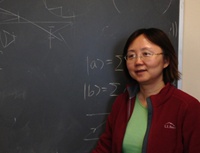Study of bird feathers might lead to better colours in the future
By By Brita Belli | 08 Aug 2013
Yale professor Hui Cao hopes to replicate the brilliant colours of bird feathers in the laboratory, in this case using lasers.
 | |
| Hui Cao won a Guggenheim Fellowship last spring for her work in biologically inspired photonics. (Photo by Brita Belli) |
Cao, professor of applied physics, was one of 175 scholars, artists and scientists awarded a Guggenheim fellowship this past April for her work in biologically inspired photonics.
The research honoured by the fellowship deals with structural colouration - specifically the way that colour is generated in nature, particularly in bird feathers, and how that might be replicated in the lab using biological nanostructures to produce equally brilliant colours using lasers.
Cao has collaborated with several Yale faculty members on this research, including Richard Prum, the William Robertson Coe Professor of Ornithology, and Eric Dufresne, associate professor of mechanical engineering and materials science and director of the Center for Engineering Innovation and Design.
''We started by studying the colour of bird feathers,'' says Cao, ''and how birds produce such brilliant, vivid colours.'' The research team found that the colour in bird feathers comes from combinations of nanostructures and pigments. A blue jay's blue, for instance, comes from nanostructures with melanin underneath; birds with brilliant white feathers have no such melanin.
''We can take what we have learned from nature to make better photonic devices,'' says Cao. And, she adds, ''If we learn how to make artificial colours using nanostructures rather than dyes, we can use environmentally friendly materials.''
These artificial colours will have another desirable property - the colours will not fade. As part of her research, Cao studied pigment in 40 million-year-old fossil beetles and 47 million-year-old moths whose colouring had remained intact.
Such fade-less, environmentally friendly colours hold great potential for a range of commercial products, including cars, house paint, cosmetics and clothing, as well as holding promising applications for artists. Cao says these biologically-inspired colors may also be used in digital displays, allowing for Kindle and other mobile devices to display colors that don't alter with the viewing angle.
Currently, Cao's group has applied her findings to two-dimensional structures. Next, they will work on creating a three-dimensional bio-inspired laser. To create it, they intend to use bird feather barbs as a template and infuse an active material. Once the biomaterials are removed, the laser will produce brilliant color in all directions.







.webp)























